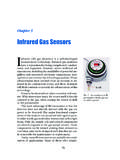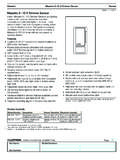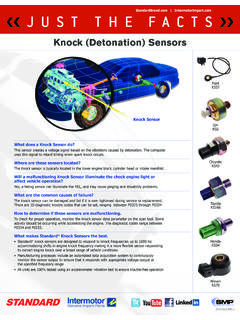Transcription of AWR1642 mmWave sensor - Texas Instruments
1 AWR1642 mmWave sensor :76 81-GHz radar-on-chip for short-range radar applicationsJasbir SinghSoC ArchitectBrian GinsburgmmWave Systems ManagerSandeep RaoRadar Systems ArchitectKarthik RamasubramanianRadar Systems ManagerTexas InstrumentsAWR1642 mmWave sensor : 2 May 201776 81-GHz radar-on-chip for short-range radar applicationsIntroductionThe use of radar technology has grown tremendously in recent years. In the automotive context, the primary radar applications can be broadly grouped into corner radars and front radars. Corner radars (rear and front) are typically short-range radar sensors that handle the requirements of blind-spot detection (BSD), lane-change assist (LCA) and front/rear cross-traffic alert (F/RCTA), while front radars are typically mid- and long-range radars responsible for autonomous emergency braking (AEB) and adaptive cruise control (ACC).Traditionally, corner radars were based on 24-GHz technology. However, there is a shift in the industry toward the 77-GHz frequency band due to emerging regulatory requirements, as well as the larger bandwidth availability, smaller sensor size and performance white paper introduces the AWR1642 device as a highly integrated 76 81-GHz radar-on-chip solution for short-range radars.
2 The device comprises the entire millimeter wave ( mmWave ) radio-frequency (RF) and analog baseband signal chain for two transmitters (TX) and four receivers (RX), as well as two customer-programmable processor cores in the form of a C674x digital signal processor (DSP) and an ARM Cortex -R4F microcontroller (MCU). In the next few sections, we will present the high-level architecture and features of the AWR1642 device and show sample illustrations of chirp configurations for typical use high-level architectureThe AWR1642 device is a highly integrated single-chip 77-GHz radar-on-chip device that includes two transmit and four receive chains, a 600-MHz user-programmable C674x DSP and a 200-MHz user-programmable ARM Cortex-R4F processor. The device supports wide RF bandwidth, covering both the 76 77-GHz and 77 81-GHz bands. As Figure 1 on the following page shows, the device comprises four main subsystems: the RF/analog subsystem, the radio processor subsystem, the DSP subsystem and the master subsystem.
3 The RF/analog subsystem includes the RF and analog circuitry: the synthesizer, power amplifiers (PAs), low-noise amplifiers (LNAs), mixers, intermediate frequency (IF) chains and analog-to-digital converters (ADCs). This subsystem also includes crystal oscillators, temperature sensors, voltage monitors and a general-purpose AWR1642 device uses a complex baseband architecture and provides in-phase (I-channel) and quadrature (Q-channel) outputs. A separate white paper titled Using a complex-baseband architecture in FMCW radar systems describes the advantages of a complex-baseband mmWave sensor : 3 May 201776 81-GHz radar-on-chip for short-range radar applicationsThe radio processor subsystem (also known as the built-in self-test [BIST] subsystem) includes the digital front-end, the ramp generator and an internal processor for controlling and configuring low-level RF/analog and ramp generator registers based on well-defined application programming interface (API) messages from the master or DSP subsystem.
4 (Note: this radio processor is TI-programmed and takes care of RF calibration needs and BIST/monitoring functions; the processor is not available directly for customer use.) The digital front end takes care of filtering and decimating the raw sigma-delta ADC output and provides the final ADC data samples at a programmable sampling DSP subsystem includes a TI C674x DSP clocked at 600 MHz for radar signal processing typically the processing of raw ADC data until object detection. This DSP is customer-programmable, and enables full flexibility when using proprietary master subsystem includes ARM s automotive-grade Cortex-R4F processor clocked at 200 MHz, which is customer-programmable. This processor controls the overall operation of the device, handles the communication interfaces, and typically implements higher-layer algorithms such as object classification and tracking. This processor can run Automotive Open System Architecture (AUTOSAR) if AWR1642 mmWave sensor can function as an autonomous radar-on-chip sensor for short-range radar (SRR) applications.
5 The device includes a Quad Serial Peripheral Interface (QSPI), which can download customer code directly from a serial Flash. A Controller Area Network-Flexible Data Rate (CAN-FD) interface and an additional (classic) CAN interface are included so that the sensor can communicate directly with the vehicle CAN bus or with other sensors on a private CAN bus. An SPI/Inter-Integrated Circuit (I2C) interface is available for power-management integrated circuit (PMIC) control when using the AWR1642 device as an autonomous (Decimationfilter chain)LNAIFADCLNAIFADCLNAIFADCLNAPAPAS ynth(20 GHz) (BIST)processor(For RF Calibrationand Self-test TIprogrammed)ProgRAMand ROMDataRAMGPADCVMONTempCortex-R4 Fat 200 MHz(Userprogrammable)ProgRAM(256kB*)Data RAM(192kB*)BootROMQSPISPISPI /I2 CDebugUARTsDCANDMATest/DebugADCB ufferLVDSRF/AnalogsubsystemRadioprocesso rsubsystem(TI programmed)Mastersubsystem(Customerprogr ammed)SerialflashinterfaceOptionalExtern alMCUinterfacePMIC controlPrimarycommunicationinterfaces(au tomotive)For debugJTAG for debug/developmentHigh-speedADCoutputinte rface(for recording)*Upto 512 KBof RadarDataMemorycan be switchedto the MasterR4 Fif required6 CAN-FDDSP subsystem(Customerprogrammed)MailboxBus MatrixHILHigh-speedinputforhardware-in-l oopverificationC674xDSPat 600 MHzL1P(32kB)L1D(32kB)L2(256kB)DMACRCR adarDataMemory(L3)
6 768 kB*Figure 1. AWR1642 high-level mmWave sensor : 4 May 201776 81-GHz radar-on-chip for short-range radar applicationsMemory partitionThe total memory available on the AWR1642 mmWave sensor is MB. This is partitioned between the R4F program RAM, R4F data RAM, DSP L1 and L2 memory and radar data memory (L3 memory). Table 1 lists some example memory configurations. The L2 memory in the DSP subsystem is 256 KB and typically used for instruction and immediate data for the DSP application. The DSP subsystem also includes 32 KB each of L1 program and data RAMs, which are configurable as cache, either in full or partially. The R4F has dedicated memory of 448 KB, which is partitioned between the R4F s tightly coupled memory interfaces viz., TCMA (256 KB) and TCMB (192 KB). Although the complete 448-KB memory is unified and useable for instruction or data, typical applications use TCMA as instruction memory and TCMB as data memory. The remaining 768 KB is L3 memory, which is available as radar data cube memory.
7 It is also possible to share up to 512 KB of L3 memory for the R4F in 128-KB RAMDSP L2 RAMR adar data memory1448 KB256 KB768 KB2576 KB256 KB640 KB3704 KB256 KB512 KBTable 1. Example memory DSP advantageOne of the key advantages of the AWR1642 device is its built-in C674x DSP. Frequency-modulated continuous-wave (FMCW) radar technology has evolved significantly in the past several years and continues to do so. Automotive manufacturers are adding more applications as radar plays a larger role in modern vehicles, both for driver comfort and safety. These emerging applications also make radar performance requirements tighter in terms of spatial resolution, velocity resolution and object detection and availability of a fully programmable DSP in the AWR1642 device enables you to implement proprietary algorithms and build innovative solutions to address difficult challenges with respect to radar performance. Research advancements continue around algorithms to improve performance in several critical areas, such as: Interference mitigation: As more vehicles deploy radar technology, the problem of interference between radars becomes important.
8 In this context, an active area of research and signal-processing algorithm development is in innovative algorithms for detecting and mitigating interference. Improved detection algorithms: Due to new emerging applications for radar, including the ultimate vision of fully automated driving, there is a need for improved algorithms related to object detection, ground clutter removal and minimizing false detections to ensure robustness. High-resolution angle estimation: One of the key challenges associated with radar sensors is the limited angular resolution natively available. Several advanced angle-estimation algorithms beyond traditional beamforming are possible to improve angular resolution, including Multiple Signal Classification (MUSIC) and Estimation of Signal Parameters via Rotational Invariance Technique (ESPIRIT). Clustering and object-classification algorithms: This is another active area of research and algorithm development, especially in the context of object classification using AWR1642 mmWave sensor : 5 May 201776 81-GHz radar-on-chip for short-range radar applicationsa high-resolution radar-point cloud and the identification of pedestrians using techniques such as these needs, the built-in DSP enables high performance and fully programmable signal-processing capability.
9 Table 2 provides some benchmark data for the performance of the DSP in a few typical radar signal-processing mmWave sensor provides a secure boot mechanism. Secure boot, a type of security enabler, provides the mechanism to help keep the code/algorithms in an encrypted form and help protect it from unauthorized access. Also, it helps avoid the implantation of rogue code on to a device, thus protecting the device from running an altered speed up the coding and decoding process which is computation intensive, the AWR1642 mmWave sensor is equipped with hardware-based accelerator security features which can also be used by the application code for additional security implementation: Advanced Encryption Standard (AES). Secure Hash Accelerator (SHA2). True Random Number Generator (TRNG). Public Key Accelerator (PKA).Further, the AWR1642 sensor provides a secure debugging mechanism, making debugging hassle-free while helping protect the device from various AWR1642 sensor is part of TI s SafeTI design package to assist developers to achieve International Organization for Standardization (ISO) 26262 Automotive Safety Integrity Level (ASIL) B in their AWR1642 sensor follows a concept called Safe Island, which involves a balance between the application of hardware diagnostics and software diagnostics to help manage functional safety.
10 A core set of elements are tested thoroughly at power up and monitored closely to help provide correct software execution. This core set of elements includes the power supply, clocks, resets, and the R4F processor, interconnect and associated program and data memory to assist with the execution of software, enabling software-based diagnostics on other device elements such as device includes advanced built-in circuits for on-chip monitoring of the RF and analog front-end, both online during functional chirp periods and offline during inter-chirp and inter-frame idle periods. The dedicated radio processor (delayed lock step) core running TI s firmware helps ease application development and completely offloads the DSP and MCU processor million instructions per second (MIPS) from any kind of radar front-end monitoring. The AWR1642 sensor supports these front-end diagnostic features: Synthesizer chirp-frequency monitor. TX output-power cycles(C674x DSP)Execution time (at 600 MHz)1128-pt fast Fourier transform (FFT) (16-bit) s2256-pt FFT (16-bit) s3512-pt FFT (16-bit)2, s4 Windowing(length N vector) + s (for N = 256)5 Log magnitude (16-bit) + s (for N = 256)6 Constant false-alarm rate-cell averaging (CFAR-CA) (for N cells)3N + s (for N = 256)Table 2.

















